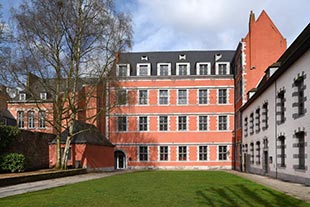In Wallonia (Belgium), Mons has transformed the former Mont de Piété into a museum dedicated to its 'Doudou', the ritual ducasse of the city. This annual celebration at the time of the Trinity, celebrates the myth of St. George slaying the Dragon. In 2005, the Ducasse de Mons has been recognised by UNESCO as an "oral and intangible part of human heritage". The Musée du Doudou allows these historic traditions to be discovered through a an interpretative route combining interactivity and virtual reality. Several direct and indirect jobs have been created. Tourism has increased.
The Musée du Doudou values the ritual Ducasse de Mons and the legend of St. George.
- 11 December 2017
The Museum is intended for people from Mons who know 'Doudou' by heart, but also for tourists from abroad who are discovering it for the first time. The objective of transmission of the Ducasse de Mons between generations, is central.
The weekend of the Trinity, residents crowd the streets by the thousands to participate in the Ducasse de Mons. The festival celebrates the history of the city through the figure of its founder, St. Waudru. A descent from the shrine of the relics and a procession precede a staged fight called 'Lumeçon', which plays out the myth of St. George slaying the Dragon.
The Musée du Doudou invites you to relive this festive tradition of Mons through an interpretive route garnished with explanations, films, objects, music, and more. It also offers educational activities adapted to the age of the participants.
Housed in the former Mont de Piété, the Musée du Doudou is located not far from the Grand'Place in Mons in the garden of the Mayor. A true centre of interpretation, it combines several perspectives: historical, anthropological, scientific, artistic, secular and religious. During the visit, the public can discover the various highlights of the festival. It is aware of its meaning and its importance in the eyes of the inhabitants of Mons and tourists or visitors.
The Museum provides the keys to reading the prevailing state of mind that reigns in the heart of the city during Ducasse: each year in Trinity, in May or June according to the schedule, the crowd gathers on the square in front of City Hall to applaud St. George slaying the Dragon with a final shot of his pistol. The visitor to the Musée du Doudou can understand how this festive rite is one of the foundations of the sense of identity of Mons people.
Since its opening in mid-2015, under the framework of "Mons 2015, European Capital of Culture", the Musée du Doudou has continued to attract visitors. There were 15 000 in 2016 and already nearly 14 000 have visited between January and November 2017. ‘The Museum is mainly visited by locals as well as by tourists, the majority of whom are children and families. Specific mediation work is carried out each year by several dynamic mediators (educational service of the Museum Hub of Mons), who welcome mainly groups of children to the Doudou. The “birthday" formula every Wednesday afternoon also meets with great success,' says Manuela Valentino, curator of UNESCO Heritage, City of Mons.
To meet the interest of tourists, guided tours have been implemented in several languages (French, English, Dutch, German, Italian, Spanish and Chinese). On the economic front, the attractiveness of the place has given rise to a dozen shops in the area of the Grand'Place and the adjacent streets. It has also allowed the creation of several direct full-time or part-time positions: curator of UNESCO Heritage and their assistant, a facilitator, two welcome officers and two caretakers. Several other jobs have also been created, such as independent guides and maintenance staff.
In addition, the Museum has contributed to indirect jobs, for example by asking regional companies to make objects and publications for its shop. Finally, it helps to create synergies with other sites of the city like the belfry.
Total investment and EU funding
A total of EUR 3 729 088 was invested in the 'Musée du Doudou de Mons' project. The European Regional Development Fund contributed EUR 1 478 359 under the Wallonia (Hainaut) Operational Programme for the 2007-2013 programming period.

